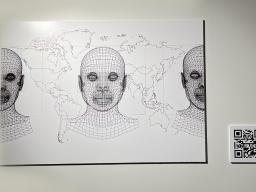55 CANCRI E: Featuring Chenfei Xiao
Detail of the artwork Spin : Breathe : Pump
1 December 2022
Spin : Breathe : Pump
Augmented Reality.
This blog post was provided by Chenfei Xiao as part of the We Bleed the Same Masterclass program. The WBTS Masterclasses brought together seven outstanding ANU students to learn about how art can be used as part of a campaign against racism. The Masterclass launched these artworks at the 55 CANCRI E Exhibition in Novemeber 2022.
Artist's Statement
Spin : Breathe : Pump is an image target–based augmented reality (AR) art installation featuring a 118.8 x 84.1 cm digital print hung on the wall and a continuously looping 15-second computer-generated imagery (CGI). Participants must use a nearby iPad or scan a QR code using their devices to access the Spin Breathe Pump application, which allows them to view the CGI on their smartphones by pointing the camera at the printed image. Inspired by recent studies on racism in facial recognition technology, this work explores racism from a biological perspective. It is essential to acknowledge the morphological differences between races: they embody a rich social and cultural history and aesthetic and do not make us less human; fundamentally, we bleed the same, we breathe the same, and our hearts pump the same. It is through such diversity and similarity that a productive human society is constructed.
Furthermore, racism should not be seen as mere racial categorisation but as caused by a persistent framework of white supremacy that creates a racial hierarchy in the world, resulting in a cultural, social, and aesthetic convergence of the world around the white race. For example, many samples and test data used in current facial recognition algorithms are based on the white race, resulting in centralised recognition based on white race features. Therefore, this work addresses racism by highlighting human diversity and similarity through assemblage and décollage in and between the image target and CGI. A combination of software applications was used in this work: Character Creator 3 (CC3), Blender, Audacity, Photoshop, Vuforia, ZapWorks and Unity. I started by creating a humanoid 3D model based on me via the Headshot plugin in CC3. I then transferred it to Blender for decomposition into a wireframe head bust and converted it from a 3D model to a high-resolution 2D graphic through a rendering process. This process was repeated for two other anonymous face models from different racial backgrounds.
A ready-made topographic world map was also turned into a wireframe image. The final assemblage of the image target was conducted in Photoshop. All three wireframe head-bust images were put together in a landscape view with the wireframe topographic world map as the background, highlighting the importance of equality in the global scene. The rectangles act as a visual representation of facial recognition and sarcastically question the biased algorithm, further highlighting that morphological differences are typical human features. Regarding the CGI design, the head bust of myself was animated to spin in place and change facial expressions with each spin in Unity. I then recorded the sound of my breath while thinking about my previous experiences with racism to provide an abstract narration of these experiences. A deformed heart model was created in Blender and animated based on the breath using the ‘f-curve modifier’. By texturing the heart with rainbow colours, I also bring my queer perspective of equality into this practice.
Biography
I am a reality media artist specialising in immersive installation and performance design. I am currently pursuing a Master of Contemporary Practices in Art and Design at the Australian National University, Canberra, focusing on investigating reality media in immersive performances. My practice explores social, cultural, and political shifts in a post-digital society enabled by increasingly advanced reality media and addresses issues such as racial, gender, and sexual inequality and discrimination. Growing up in an LGBTQ-unfriendly environment in China at the time, my queer identity created a conflict in my emotional self-awareness. Therefore, in 2011, I decided to continue high school in Australia. However, my journey here has had its challenges. The most significant is the racism experienced by me and my family. Sometime in 2012, I took a bus to Mansfield Park from Adelaide, as usual, after class. Unexpectedly, I felt a rough push from behind when inserting my ticket, which made me stumble. I was so shocked that I was unable to react. After taking a seat, a thuggish-looking man soon walked straight towards me and started swearing and threatening me with racist comments, including, “I will f###ing cut your throat, you Chinese dog”. That was my first experience of overt racism. It was a dreadful trip, as he continued to verbally abuse me the entire time from the row behind me, and neither me nor the other passengers responded. The world became silent as my ears buzzed, and all I could hear was my heart pumping and my breathing. From appearance to language and social norms to knowledge, a racial hierarchy is constructed through covert racism daily. I thus became less vocal and confident regarding my racial identity and cultural background, thinking that hiding them keeps me safe, but I also wondered, “How do I hide my biological self?” Over the past three years, during my honours and master’s studies, I was able to reclaim my racial identity and break myself free from the problematic racial hierarchy within a more supportive environment and by gaining relevant knowledge from the literature.
“In the present days, I experience more covert racism. It is not through direct language but general treatments or sarcasm that make me experience a weird disrespect.”

